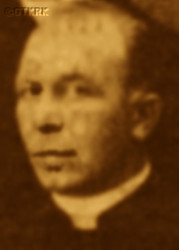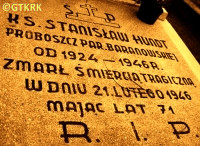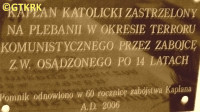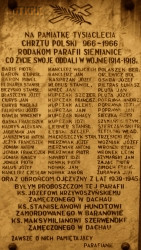Roman Catholic
St Sigismund parish
05-507 Słomczyn
85 Wiślana Str.
Konstancin deanery
Warsaw archdiocese, Poland
full list:
displayClick to display full list

searchClick to search full list by categories
wyświetlKliknij by wyświetlić pełną listę po polsku

szukajKliknij by przeszukać listę wg kategorii po polsku

Martyrology of the clergy — Poland
XX century (1914 – 1989)
personal data
surname
HUNDT
forename(s)
Stanislav Anthony (pl. Stanisław Antoni)
function
diocesan priest
creed
Latin (Roman Catholic) Church RCmore on
en.wikipedia.org
[access: 2014.09.21]
diocese / province
Gniezno and Poznań archdiocese (aeque principaliter)more on
www.archpoznan.pl
[access: 2012.11.23]
date and place
of death
20.02.1946

Baranówtoday: Baranów gm., Kępno pov., Greater Poland voiv., Poland
more on
en.wikipedia.org
[access: 2021.07.18]
alt. dates and places
of death
21.02.1946
details of death
When in 1906‐1908 a strike of school children broke out in the Prussian part of partitioned Poland, i.e. in Germ. Provinz Posen (Eng. Poznań Province) — children refrained from answering in German during religion lessons; parents certified in writing that they did not allow their children to answer in German during religion lessons; children began their classes with a morning prayer in Polish, greeted their teachers with the traditional Polish „Praised be Jesus Christ” — which covered almost 800 schools (25‐60% of all schools in each district) and up to 75,000 students, was tried before the Germ. Strafkammer (Eng. Penal Chamber) in Ostrów Wielkopolski, together with three other Catholic priests, for „inciting resistance against the authorities”. The reason for the repression was the reading in the church on 14.10.1906 of a pastoral letter by the seriously ill metropolitan of Gniezno and Poznań, Abp Florian Stablewski — died on 24.11.1906 — in which presented the unsuccessful efforts he had made to support the Polish cause, and encouraged the religious upbringing of children in Polish. Sentenced under Art. 10 of the Penal Code to a fine of 200 marks or 20 days of arrest. Participant in many election rallies in the Germ. Kreis Kempen (Eng. Kępno County), the southernmost and easternmost part of the Prussian Germ. Provinz Posen — bordering to the east across the Prosna River with the Russian part of partitioned Poland, i.e. Rus. Царство Польское (Eng. Kingdom of Poland), and to the south by the Prussian Germ. Provinz Schlessien (Eng. Province of Silesia) — supporting Polish candidates to the Germ. Preußischer Landtag (Eng. Prussian National Parliament) — i.a. on 17.05.1908 in Kępno, before the 1908 elections, and on 04.05.1913 in Opatów, before the 1913 elections — and to the Germ. Reichstag (Eng. Reichs Parliament) of the German Empire — i.a. on 03.12.1911 in Siemianice, before the elections in 1912. On 24.11.1912 organized a protest rally in Siemianice against the resolution on the expropriation of peasants. Since 1886, the German colonization law Germ. „Gesetz betreffend die Beförderung deutscher Ansiedlungen in den Provinzen Westpreußen und Posen” (Eng. „Law on German settlement in the province of West Prussia and Poznań”) was in force, under which the Germ. Königlich Preußische Ansiedlungskommission für Westpreußen und Posen (Eng. Royal Prussian Settlement Commission for West Prussia and Poznań), known as the Colonization Commission, purchased lands belonging to Polish farmers and settled Germans on them. On 20.03.1908 an amendment to this act came into force, allowing for the forced expropriation of Poles.
After the abdication on 09.11.1918 of the German Emperor William II Hohenzollern; after the signing on 11.11.1918 by the Allies and the Germans, in the staff carriage in Compiègne, at the headquarters of French Marshal Ferdinand Foch, of the armistice and ceasefire — which de facto meant the end of World War I; and also after the handover on 11.11.1918 by the Regency Council — operating in the so‐called Germ. Königreich Polen (Eng. Polish Kingdom), i.e. the territory occupied by the Central Powers (Germany and Austria–Hungary) — the granting of supreme command over the army to Brigadier Joseph Piłsudski and his appointment as Commander‐in‐Chief of the Polish Army, which de facto meant the rebirth of the Polish state, covering, however, only the Germ. Königreich Polen, i.e. the Polish territory under Russian rule until 1915, and not including the lands of the Prussian partition; Greater Poland — as the Prussian Germ. Provinz Posen — still formally remained part of the German state. The Germans occupied Kępno — which was also the seat of a Catholic deanery — with a 1,000‐strong post of the Germ. Grenzschutz Ost (Eng. Eastern Border Guard), a German paramilitary, terrorist, volunteer formation that militarily opposed the separation of the eastern territories from Germany. His Siemianice parish also found itself under the control of the Germ. Grenzschutz Ost. The villages, however, especially in the north of the county, were Polish. The Germans had no intention of giving up control of the county, quite the opposite — their intentions were summed up by the opinion about Polish villages: Germ. „Das ferfluchte Polennest mus ausgereuchert warden” (Eng. „We have to burn out the cursed Polish nest”).
When the Greater Poland Uprising broke out on 27.12.1918, one of the goals of the insurgents — the units formed near Ostrzeszów — was to liberate the Kępno region. The insurgents planned to attack Kępno on 17‐18.02.1919, but their plans were betrayed, and Kępno — like Siemianice — remained in German hands. The Germans conducted a search of his church and rectory. They planned to arrest him, but after being warned, escaped and moved to Wyszanów, in the north of the district, which was under Polish control. There, stayed with the local parish priest, Fr Edward Gramlewicz. On 16.02.1919, a truce was concluded in Trier ending the Uprising.
The Polish insurgent Greater Poland Army was recognized as an allied army and a border was established, which „German troops were forbidden to cross”, leaving a large part of Greater Poland outside their influence. However, Kępno and Siemianice remained in German hands, and the Germans, despite the ceasefire, continued to attack Polish positions locally until c. 07.1919. On 26.06.1919, however, the victorious Entente powers and Germany signed a peace treaty in Versailles. Under its terms, Greater Poland was awarded to Poland, and although the determination of the precise border line was left to the international Delimitation Commission, the Kępno county with Kępno and Semianice was awarded to Poland. Despite this, when on 29.08.1919 returned to Siemianice, was immediately by the Germans arrested. In 09.1919 appeared before a court martial in Opole, the seat of the Germ. Regierungsbezirk Oppeln (Eng. Opole Regency), which was part of the Germ. Provinz Schlessien. The case was nevertheless publicized and after the intervention of the Polish Ministry of the former Prussian District — established after the self‐dissolution of the National People's Council in Poznań — was released. The Treaty of Versailles came into force on 10.01.1920 — after the necessary ratifications — and the Germans left Kępno and Siemianice on 17.01.1920.
After German and Russian invasion of Poland in 09.1939 and start of the World War II, after start of German occupation, arrested by the Germans on 06.10.1941, during mass arrests of Polish clergy in occupied German province Germ. Reichsgau Wartheland (Eng. Wartheland Reich District).
Released but evicted from his parish and forced to settle in Doruchów and live in a damp mill, c. 2 km from the parish church.
Was the only Catholic priest in the Kępno and Ostrzeszów deaneries.
Clandestinely ministered to his parishioners — blessed marriages, baptised newborn and prepared childred for the first Communion.
After Russian victory and start of Russian occupation tortured and shot in the vicarage — body was found in his own bed, under the duvet, riddled with five bullets — prob. by Russian controlled Polish NKVD branch, Commie‐Nazi UB, for refusal to reveal the secrets of confession.
cause of death
murder
perpetrators
Russians / Poles
sites and events
06.10.1941 arrests (Warthegau)Click to display the description, Reichsgau WarthelandClick to display the description, Ribbentrop‐MolotovClick to display the description, Pius XI's encyclicalsClick to display the description, Greater Poland UprisingClick to display the description
date and place
of birth
07.02.1875Birth certification on:
www.genealogiawarchiwach.pl
[access: 2025.11.05]

Sławsk Wielkitoday: Kruszwica gm., Inowrocław pov., Kuyavia‐Pomerania voiv., Poland
more on
pl.wikipedia.org
[access: 2020.09.18]
parents
HUNDT Joseph
🞲 ?, ? — 🕆 ?, ?

WOŹNIEWSKA Josefa
🞲 ?, ? — 🕆 ?, ?
presbyter (holy orders)
ordination
01.12.1902

Gnieznotoday: Gniezno urban gm., Gniezno pov., Greater Poland voiv., Poland
more on
en.wikipedia.org
[access: 2021.12.18]
Assumption of the Blessed Virgin Mary RC archcathedral churchmore on
en.wikipedia.org
[access: 2025.03.14]
positions held
1945 – 1946
parish priest — Baranówtoday: Baranów gm., Kępno pov., Greater Poland voiv., Poland
more on
en.wikipedia.org
[access: 2021.07.18] ⋄ St Lawrence the Martyr and St Andrew the Apostle RC parish ⋄ Kępnotoday: Kępno gm., Kępno pov., Greater Poland voiv., Poland
more on
en.wikipedia.org
[access: 2021.05.30] RC deanery
1941 – 1945
resident — Doruchówtoday: Doruchów gm., Ostrzeszów pov., Greater Poland voiv., Poland
more on
en.wikipedia.org
[access: 2021.07.18] ⋄ St Stanislav Kostka the Confessor RC parish ⋄ Ostrzeszówtoday: Ostrzeszów gm., Ostrzeszów pov., Greater Poland voiv., Poland
more on
en.wikipedia.org
[access: 2021.05.30] RC deanery
1924 – 1941
parish priest — Baranówtoday: Baranów gm., Kępno pov., Greater Poland voiv., Poland
more on
en.wikipedia.org
[access: 2021.07.18] ⋄ St Lawrence the Martyr and St Andrew the Apostle RC parish ⋄ Kępnotoday: Kępno gm., Kępno pov., Greater Poland voiv., Poland
more on
en.wikipedia.org
[access: 2021.05.30] RC deanery
1918 – 1924
parish priest — Siemianicetoday: Łęka Opatowska gm., Kępno pov., Greater Poland voiv., Poland
more on
en.wikipedia.org
[access: 2021.07.18] ⋄ St Giles the Abbot RC parish ⋄ Kępnotoday: Kępno gm., Kępno pov., Greater Poland voiv., Poland
more on
en.wikipedia.org
[access: 2021.05.30] RC deanery — also: c. 1914 co‐founder, member of the management board, and later member of the Supervisory Board of the People's Bank in Siemianice
1910 – 1918
administrator — Siemianicetoday: Łęka Opatowska gm., Kępno pov., Greater Poland voiv., Poland
more on
en.wikipedia.org
[access: 2021.07.18] ⋄ St Giles the Abbot RC parish ⋄ Kępnotoday: Kępno gm., Kępno pov., Greater Poland voiv., Poland
more on
en.wikipedia.org
[access: 2021.05.30] RC deanery
1904 – 1910
administrator — Donaborówtoday: Baranów gm., Kępno pov., Greater Poland voiv., Poland
more on
en.wikipedia.org
[access: 2021.05.30] ⋄ St Martin the Bishop and Confessor RC parish ⋄ Kępnotoday: Kępno gm., Kępno pov., Greater Poland voiv., Poland
more on
en.wikipedia.org
[access: 2021.05.30] RC deanery
1902 – 1904
vicar — Miłosławtoday: Miłosław gm., Września pov., Greater Poland voiv., Poland
more on
en.wikipedia.org
[access: 2021.07.18] ⋄ St James the Great the Apostle RC parish ⋄ Miłosławtoday: Miłosław gm., Września pov., Greater Poland voiv., Poland
more on
en.wikipedia.org
[access: 2021.07.18] RC deanery
till 1902
student — Gnieznotoday: Gniezno urban gm., Gniezno pov., Greater Poland voiv., Poland
more on
en.wikipedia.org
[access: 2021.12.18] ⋄ philosophy and theology, Archbishop's Practical Theological Seminary (Lat. Seminarium Clericorum Practicum)
from 1899
student — Poznańtoday: Poznań city pov., Greater Poland voiv., Poland
more on
en.wikipedia.org
[access: 2021.07.18] ⋄ philosophy and theology, Archbishop's Theological Seminary (Collegium Leoninum)
till 1899
pupil — Chełmnotoday: Chełmno urban gm., Chełmno pov., Kuyavia‐Pomerania voiv., Poland
more on
en.wikipedia.org
[access: 2021.07.25] ⋄ Germ. Königliche Katholische Gymnasium (Eng. Royal Catholic Gymnasium) — studies completed on 24.04.1899 with the maturity diploma (i.e. matura)
pupil — Inowrocławtoday: Inowrocław gm., Inowrocław pov., Kuyavia‐Pomerania voiv., Poland
more on
en.wikipedia.org
[access: 2021.07.18] ⋄ Germ. Königliche Gymnasium (Eng. Royal Gymnasium)
sites and events
descriptions
06.10.1941 arrests (Warthegau): On 13.09.1941 Germ. Gauleiter (Eng. regional leader) of German province Germ. Reichsgau Wartheland (Eng. Wartheland Reich district), in German‐occupied Greater Poland (where German standard law was in force), Artur Greiser, implementing „Ohne Gott, ohne Religion, ohne Priesters und Sakramenten” — „without God, without religion, without priest and sacrament” — policy issued a decree formally dissolving Catholic Church and forming in its place a Roman Catholic German National Church in Germ. Warthegau, an organization subject to a German private law. The ordinance was issued backdated to 01.09.1939, i.e. the date of the German invasion of Poland, which sanctioned the later robbery of the property of the Catholic Church acting for the benefit of the Polish population by the Germans. All the contacts with Vatican were forbidden. All the religion congregations were also dissolved. Soon after, on 06‐07.10.1941, mass arrests of Polish Catholic priests took place — c. 352 were detained. All were herded into DL Konstantinow in Konstantynów or IL Lond in Ląd on Warta river transit camps or KL Posen concentration camp (in this case, the detainees were first registered, photographed and examined in the infamous Poznań headquarters of the German political police, the Gestapo, in the former Soldier's House). On 30.10.1941 most of them were transported to KL Dachau concentration camp.
Reichsgau Wartheland: After the Polish defeat in the 09.1939 campaign, which was the result of the Ribbentrop‐Molotov Pact and constituted the first stage of World War II, and the beginning of German occupation in part of Poland (in the other, eastern part of Poland, the Russian occupation began), the Germans divided the occupied Polish territory into five main regions (and a few smaller). The largest one was transformed into Germ. Generalgouvernement (Eng. General Governorate), intended exclusively for Poles and Jews and constituting part of the so‐called Germ. Großdeutschland (Eng. Greater Germany). Two were added to existing German provinces. From two other separate new provinces were created. Greater Poland region was one of them, incorporated into Germany on 08.10.1939, by decree of the German leader Adolf Hitler (formally came into force on 26.10.1939), and on 24.01.1940 transformed into the Germ. Reichsgau Wartheland (Eng. Wartheland Reich Province), in which the law of the German state was to apply. The main axis of the policy of the new province, the territory of which the Germans recognized as the Germ. „Ursprünglich Deutsche” (Eng. „natively German”), despite the fact that 90% of its inhabitants were Poles, was Germ. „Entpolonisierung” (Eng. „Depolonisation”), i.e. forced Germanization. C. 100,000 Poles were murdered as part of the Germ. „Intelligenzaktion”, i.e. extermination of Polish intelligentsia and ruling classes. C. 630,000 were forcibly resettled to the Germ. Generalgouvernement, and their place taken by the Germans brought from other areas occupied by Germany (e.g. the Baltic countries, Bessarabia, Bukovina, etc.). Poles were forced to sign the German nationality list, the Germ. Deutsche Volksliste DVL. As part of the policy of „Ohne Gott, ohne Religion, ohne Priesters und Sakramenten” (Eng. „No God, no religion, no priest or sacrament”) most Catholic priests were arrested and sent to concentration camps. All schools teaching in Polish, Polish libraries, theaters and museums were closed. Polish landed estates confiscated. To further reduce the number of the Polish population, Poles were sent to forced labor deep inside Germany, and the legal age of marriage for Poles was increased (25 for women, 28 for men). The German state office, Germ. Rasse‐ und Siedlungshauptamt (Eng. Main Office of Race and Settlement) RuSHA, under the majesty of German law, abducted several thousand children who met specific racial criteria from Polish families and subjected them to forced Germanization, handing them over to German families. After the end of hostilities of World War II, the overseer of this province, the Germ. Reichsstatthalter (Eng. Reich Governor) and the Germ. Gauleiter (Eng. district head) of the German National Socialist Party, Arthur Karl Greiser, was executed. (more on: en.wikipedia.orgClick to attempt to display webpage
[access: 2024.06.21])
Ribbentrop‐Molotov: Genocidal Russian‐German alliance pact between Russian leader Joseph Stalin and German leader Adolf Hitler signed on 23.08.1939 in Moscow by respective foreign ministers, Mr. Vyacheslav Molotov for Russia and Joachim von Ribbentrop for Germany. The pact sanctioned and was the direct cause of joint Russian and German invasion of Poland and the outbreak of the World War II in 09.1939. In a political sense, the pact was an attempt to restore the status quo ante before 1914, with one exception, namely the „commercial” exchange of the so‐called „Kingdom of Poland”, which in 1914 was part of the Russian Empire, fore Eastern Galicia (today's western Ukraine), in 1914 belonging to the Austro‐Hungarian Empire. Galicia, including Lviv, was to be taken over by the Russians, the „Kingdom of Poland” — under the name of the General Governorate — Germany. The resultant „war was one of the greatest calamities and dramas of humanity in history, for two atheistic and anti‐Christian ideologies — national and international socialism — rejected God and His fifth Decalogue commandment: Thou shall not kill!” (Abp Stanislav Gądecki, 01.09.2019). The decisions taken — backed up by the betrayal of the formal allies of Poland, France and Germany, which on 12.09.1939, at a joint conference in Abbeville, decided not to provide aid to attacked Poland and not to take military action against Germany (a clear breach of treaty obligations with Poland) — were on 28.09.1939 slightly altered and made more precise when a treaty on „German‐Russian boundaries and friendship” was agreed by the same murderous signatories. One of its findings was establishment of spheres of influence in Central and Eastern Europe and in consequence IV partition of Poland. In one of its secret annexes agreed, that: „the Signatories will not tolerate on its respective territories any Polish propaganda that affects the territory of the other Side. On their respective territories they will suppress all such propaganda and inform each other of the measures taken to accomplish it”. The agreements resulted in a series of meeting between two genocidal organization representing both sides — German Gestapo and Russian NKVD when coordination of efforts to exterminate Polish intelligentsia and Polish leading classes (in Germany called «Intelligenzaktion», in Russia took the form of Katyń massacres) where discussed. Resulted in deaths of hundreds of thousands of Polish intelligentsia, including thousands of priests presented here, and tens of millions of ordinary people,. The results of this Russian‐German pact lasted till 1989 and are still in evidence even today. (more on: en.wikipedia.orgClick to attempt to display webpage
[access: 2015.09.30])
Pius XI's encyclicals: Facing the creation of two totalitarian systems in Europe, which seemed to compete with each other, though there were more similarities than contradictions between them, Pope Pius XI issued in 03.1937 (within 5 days) two encyclicals. In the „Mit brennender Sorge” (Eng. „With Burning Concern”) published on 14.03.1938, condemned the national socialism prevailing in Germany. The Pope wrote: „Whoever, following the old Germanic‐pre‐Christian beliefs, puts various impersonal fate in the place of a personal God, denies the wisdom of God and Providence […], whoever exalts earthly values: race or nation, or state, or state system, representatives of state power or other fundamental values of human society, […] and makes them the highest standard of all values, including religious ones, and idolizes them, this one […] is far from true faith in God and from a worldview corresponding to such faith”. On 19.03.1937, published „Divini Redemptoris” (Eng. „Divine Redeemer”), in which criticized Russian communism, dialectical materialism and the class struggle theory. The Pope wrote: „Communism deprives man of freedom, and therefore the spiritual basis of all life norms. It deprives the human person of all his dignity and any moral support with which he could resist the onslaught of blind passions […] This is the new gospel that Bolshevik and godless communism preaches as a message of salvation and redemption of humanity”… Pius XI demanded that the established human law be subjected to the natural law of God , recommended the implementation of the ideal of a Christian state and society, and called on Catholics to resist. Two years later, National Socialist Germany and Communist Russia came together and started World War II. (more on: www.vatican.vaClick to attempt to display webpage
[access: 2023.05.28], www.vatican.vaClick to attempt to display webpage
[access: 2023.05.28])
Greater Poland Uprising: Military insurrection of Poles of former German Germ. Posen Provinz (Eng. Poznań province) launched against German Reich in 1918‐1919 — after the abdication on 09.11.1918 of the German Emperor William II Hohenzollern; after the armistice between the Allies and Germany signed on 11.1.1918 in the HQ wagon in Compiègne, the headquarters of Marshal of France Ferdinand Foch — which de facto meant the end of World War I — against the German Weimar Republic, established on the ruins of the German Empire, aiming to incorporate lands captured by Prussia during partitions of Poland in XVIII century into Poland. The Republic of Poland, reborn on 11.11.1918, initially formally included only the so‐called Germ. Königreich Polen (Eng. Kingdom of Poland), i.e. the territory that had been under Russian rule until 1915 and then under the control of Central States (Germany and Austria–Hungary), but did not include the Prussian partition. Started on 27.12.1918 in Poznań and ended on 16.02.1919 with the armistice pact in Trier, forced by the victorious Entente states, which included provisions ordering Germany to cease operations against Poland and, importantly, recognizing the Polish insurgent Greater Poland Army as an allied armed force of the Entente. De facto it turned out to be a Polish victory, confirmed in the main peace treaty after World War I, the Treaty of Versailles of 28.06.1919, which came into force on 10.01.1920 and in which most of the lands of the Prussian partition were recognized as Polish. Many Polish priests took part in the Uprising, both as chaplains of the insurgents units and members and leaders of the Polish agencies and councils set up in the areas covered by the Uprising. In 1939 after German invasion of Poland and start of the World War II those priests were particularly persecuted by the Germans and majority of them were murdered. (more on: en.wikipedia.orgClick to attempt to display webpage
[access: 2016.08.14])
sources
personal:
www.wtg-gniazdo.orgClick to attempt to display webpage
[access: 2012.11.23], www.baranow.ug.gov.plClick to attempt to display webpage
[access: 2016.05.30], www.genealogiawarchiwach.plClick to attempt to display webpage
[access: 2025.11.05], www.kepnosocjum.plClick to attempt to display webpage
[access: 2016.05.30]
bibliographical:
„Lexicon of the clergy vicimised in prl in 1945‐1989”, collective work edited by Jerzy Myszor, Warsaw, 2002
„Social Activist Priests in Greater Poland”, collective work, Biographical Dictionary, vol. 1 A‐H, 2007
original images:
www.wtg-gniazdo.orgClick to attempt to display webpage
[access: 2012.11.23], kepnosocjum.plClick to attempt to display webpage
[access: 2020.07.31], kepnosocjum.plClick to attempt to display webpage
[access: 2020.07.31], mpn.poznan.uw.gov.plClick to attempt to display webpage
[access: 2014.11.28]
LETTER to CUSTODIAN/ADMINISTRATOR
If you have an Email client on your communicator/computer — such as Mozilla Thunderbird, Windows Mail or Microsoft Outlook, described at WikipediaPatrz:
en.wikipedia.org, among others — try the link below, please:
LETTER to CUSTODIAN/ADMINISTRATORClick and try to call your own Email client
If however you do not run such a client or the above link is not active please send an email to the Custodian/Administrator using your account — in your customary email/correspondence engine — at the following address:

giving the following as the subject:
MARTYROLOGY: HUNDT Stanislav Anthony
To return to the biography press below:
 Click to return to biography
Click to return to biography











